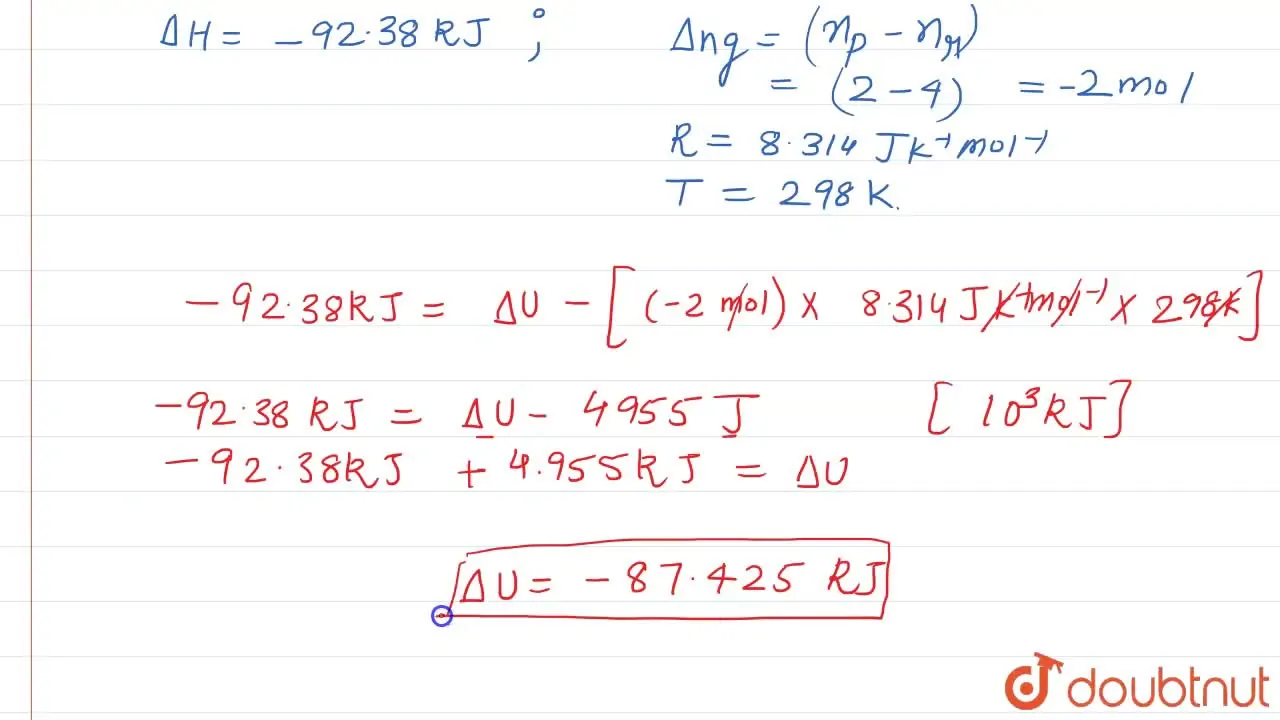The enthalpy change (ΔH) for the reaction, N2(g)+3H2(g)→2NH3g is −92.38kJ at 298K What is ΔU at 298K?
ΔH and ΔU are related as
ΔH=ΔU+ΔngRT
For the reaction,
N2(g)+3H2(g)→2NH3(g)
Δng=2−(1+3)=−2mol,T=298K
ΔH=−90.00kJ,R=8.314JK−1mol−1
−90000=ΔU+(−2mol)×(8.314Jmol−1K−1)×(298K)
−9000=ΔU−4955
ΔU=−90000+4955=85045J=−85.045kJ
Related Playlists
- BOOK - CENGAGE CHEMISTRY ENGLISHCHAPTER - THERMODYNAMICSEXERCISE - Ex 6.327videos
THERMODYNAMICS
- BOOK - CENGAGE CHEMISTRY ENGLISHCHAPTER - THERMODYNAMICSEXERCISE - Ex 6.416videos
THERMODYNAMICS
- BOOK - CENGAGE CHEMISTRY ENGLISHCHAPTER - THERMODYNAMICSEXERCISE - Ex 6.126videos
THERMODYNAMICS
- BOOK - CENGAGE CHEMISTRY ENGLISHCHAPTER - STOICHIOMETRYEXERCISE - Archives Subjective33videos
STOICHIOMETRY
Similar Questions
The enthalpy change (ΔH) for the reaction
N2(g)+3H2(g)→2NH3(g)
is −92.38kJ at 298K. What is ΔU at 298K?View SolutionThe enthalpy change (ΔH) for the reaction
N2(g)+3H2(g)→2NH3(g)
is -92.38 kJ at 298 K. What is ΔU at 298 K ? (R=8.314jK−1mol−1)View SolutionChemical reactions are invariably associated with the transfer of energy either in the form of hear or light. In the laboratory, heat changes in physical and chemical processes are measured with an instrument called calorimeter. Heat change in the process is calculated as: q= ms ΔT, s= Specific heat = cΔT= Heat capacity. Heat of reaction at constant pressure is measured using simple or water calorimeter. Qv=ΔU= Internal energy change, QP=ΔH,QP=QV+PΔVandΔH=ΔU+ΔnRT. The amount of energy released during a chemical change depends on the physical state of reactants and products, the condition of pressure, temperature and volume at which the reaction is carried out. The variation of heat of reaction with temperature and pressure is given by Kirchoff's equation: ΔH2−ΔH1T2−T1=ΔCP (At constant pressure), ΔU2−ΔU1T2−T1=ΔCV (At constant volume)
The enthalpy change (ΔH) for the reaction N2(g)+3H2(g)→2NH3(g) is −92.38kJ at 298 K. The internal energy change ΔU at 298 K isView SolutionFor the reaction
N2(g)+3H2(g)⇔2NH3(g),ΔH=?View SolutionThe internal energy change (ΔU) for the reaction CH4(g)+2O2(g)→CO2(g)+2H2O(l) is −885kJmol−1 at 298K. What is ΔH at 398 K?
View SolutionWhich of the following is correct for the reaction? N2(g)+3H2(g)→2NH3(g)
View SolutionFor the reaction, N2(g)+3H2(g)⇔2NH3(g), the units of Kp are …………
View SolutionFor the reaction
N2(g)+3H2(g)→2NH2(g)
Which of the following is correct?View SolutionFor the reactions,
N2(g)+3H2(g)⇔2NH3(g),
Kp=Kc(RT)…..View SolutionCalculate the entropy change at 298K for the reaction
Br2(l)+CI2(g)→2BrCI(g)
ΔH=29.3kJat298K. The entropies of Br2(l),CI2(g), and BrCI(g) at the above temperature and 152.3,223.0 and 239.7Jmol−1K−1 respectively.View Solution


